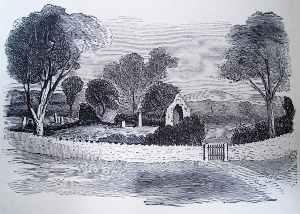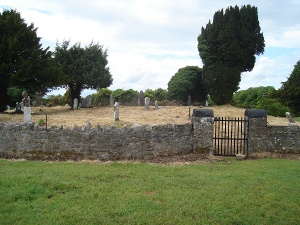St. Farnan and Downings Graveyard
Published in the Kildare Nationalist, 17th July 2009
Downings Graveyard is a very ancient site with connections to St. Farnan, an early-Christian missionary who is accredited with bringing Christianity to the Prosperous area. It is situated less than one mile west of Prosperous village in a quaint rural setting just off the Prosperous to Allenwood Road.
The surrounding wall of the graveyard is partly circular in shape and this form suggests that the burial ground dates to the early Christian period when churches were built on slightly elevated sites surrounded by circular ramparts. Downings, is one of the best surviving examples of an early Christian establishment. One of the unusual features contained in the burial ground is a portion of the original rampart in the south-western section of the boundary wall.
Downings townland has several enclosures dating from the pre-history period and it is likely that a combination of these earthworks gave Downings its name. A Dun is a ‘fort of a chieftain’ and the word ‘The Dooneens’, or in Irish ‘Na Dúiníní’ which translates ‘the small forts’ is the wording from which Downings takes its name.
In the pre-history period, Downings was an area of considerable importance and it is likely that there were pre-Christian religious activity associated with a spring. Rising water from a spring was very important to the druidic religion. In order to evangelise an area where such a practice existed the early Christian missionaries would take over these springs, bless the water and give it a Christian meaning. They would also incorporate some of the ancient activities into Christian religious practices. The spring then became a holy well which was usually named after the missionary who blessed the well and converted the people in the area. Close to Downings graveyard is the site of St. Farnan’s Holy Well. It is not known what period St. Farnan lived but it is likely to have been in the sixth or seventh century. When he began his mission in the Downings area, he ended the Drudic religious activity at the spring and it then became a holy well. He also built the first Christian church in the area. The site of this church is now identified as within the ruins of the church in Downings graveyard. These early churches were usually referred to as a ‘Cell’ and were built of timber in low-land areas of the country.
Very little is known of St. Farnan and there are conflicting dates regarding his feast day. Some antiquarians suggest that St. Farannan whose feast day occurs on the 15th of February may have been associated with Downings. However, this is unlikely as his connections are mainly with the West of Ireland. Another missionary with a similar name to Farnan was St. Forannan, Abbot of Clonard and later Abbot of Kildare. He died on the 12th of February 740. A clue as to the real St. Farnan survives in local tradition which was recorded in the 19th century. The Ordnance Survey letters from 1837 record that a pattern used to be held at St. Farnans Well annually on the 12th of June. A pattern is a festival that survives from the early Christian period. It consists of a religious element followed by feasting, singing and dancing, at a holy well on the feast day of the patron saint. Pattern festivals came to an end in many areas in the late 1700s or early 1800s. It is almost certain that the 12th of June is the feast day of St. Farnan of Downings.
According to Canon Hanlon writing in 1875,
St Farnan battled with doubt and uncertainty against drunkenness … blessed the well at Downings and called it the well of sobriety saying that whosoever drank of its water should never again relish the wants of intempe.
The earliest Christian crosses carved by the Irish Christians are referred to as cross slabs which consists of a carved slab of local stone, with a representation of the Christian cross. A number of cross slabs can be seen in Crosspatrick Graveyard and they are carved from a type of red stone which is native to the Kilmeague area. One excellent specimen of a cross slab made from Kilmeague red stone was until recent times situated in the centre of the Church ruins at Downings. It is now preserved in Prosperous Church. The likelihood is that this cross slab originated in Crosspatrick and was used as a grave memorial, to a long forgotten famous individual interred in Downings graveyard.
A record of a land transaction relating to Downings survives from the period shortly after the Norman invasion. It relates to a grant of ‘Douning or Donnyna’ in the barony of Otymy from Strongbow to Adam De Hereford. Otymy was an ancient district extending from Clane to Timahoe and is now known as the Barony of Clane. The Normans would have built the first stone church at Downings. The De Hereford family who were lords of the general area granted many churches on their lands including Downings to the Knights Hospitallers religious order. It is likely that this order were responsible for the construction of the Church which is now the ruined building in the graveyard. It dates from the medieval period and measures 42′ 6″ in length and 16′ in width.
Detail of a clergyman appointed to this Church in 1538 survives. A report naming a number of clergymen presented to benefices by Walter Wellesley bishop of Kildare names Nicholas O’Hanlon, as vicar of Downyngs (Downings). In 1540 the Knights Hospitallers were disbanded. An inquisition taken at the time shows that the rectory of Downings was of an annual value of £3–10 shillings and the advowson of the vicarage belonged to the Hospitallers.
Today the burial ground is cared for by the recently formed, ‘Downings Grayeyard Committee’ who have done tremendous work in cleaning up of the cemetery. On the 12th of June last, the committee organised a successful and well-attended ecumenical service with Rev. Kevin Ronne Rector of Clane and Fr. Hugh Gillan O.H. officiating. The event which took place on the feast day of St. Farnan may well be regarded as a continuation of a custom that extends back to the early Christian period.


